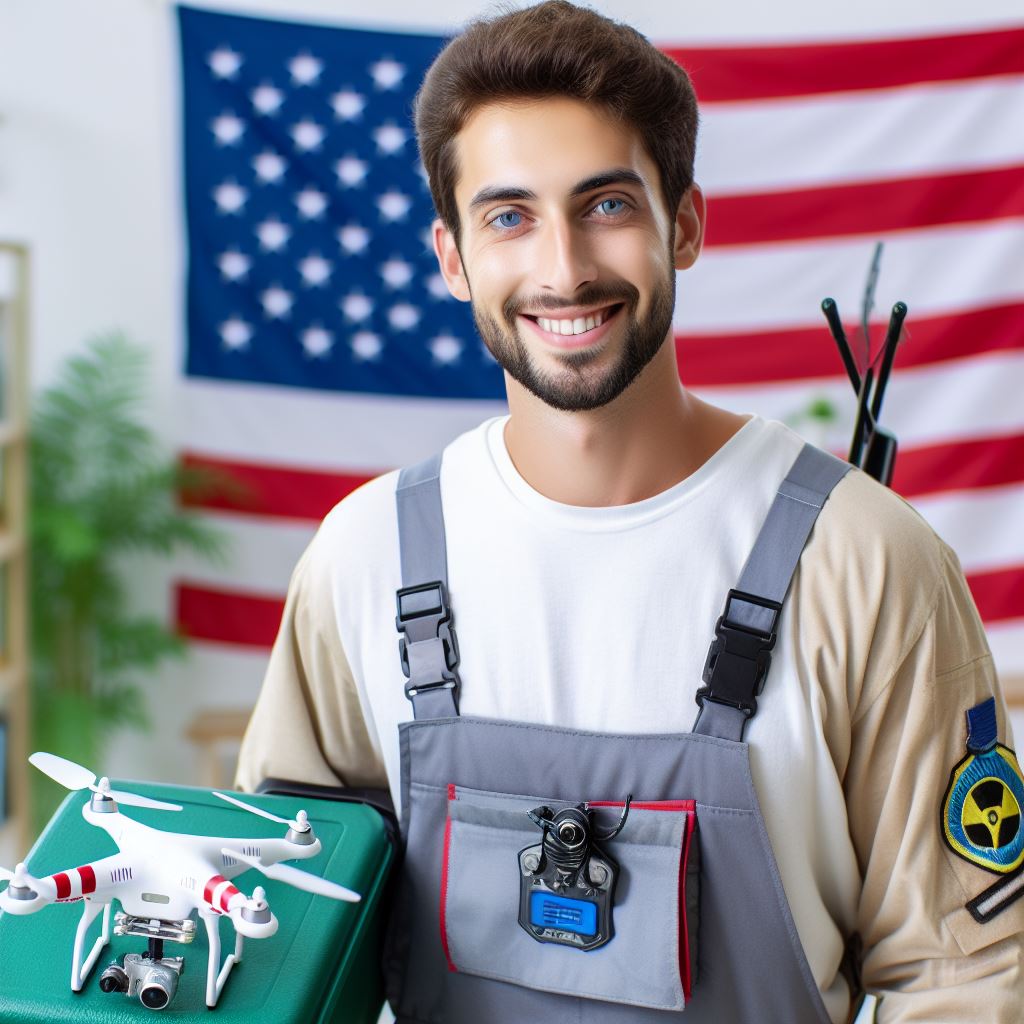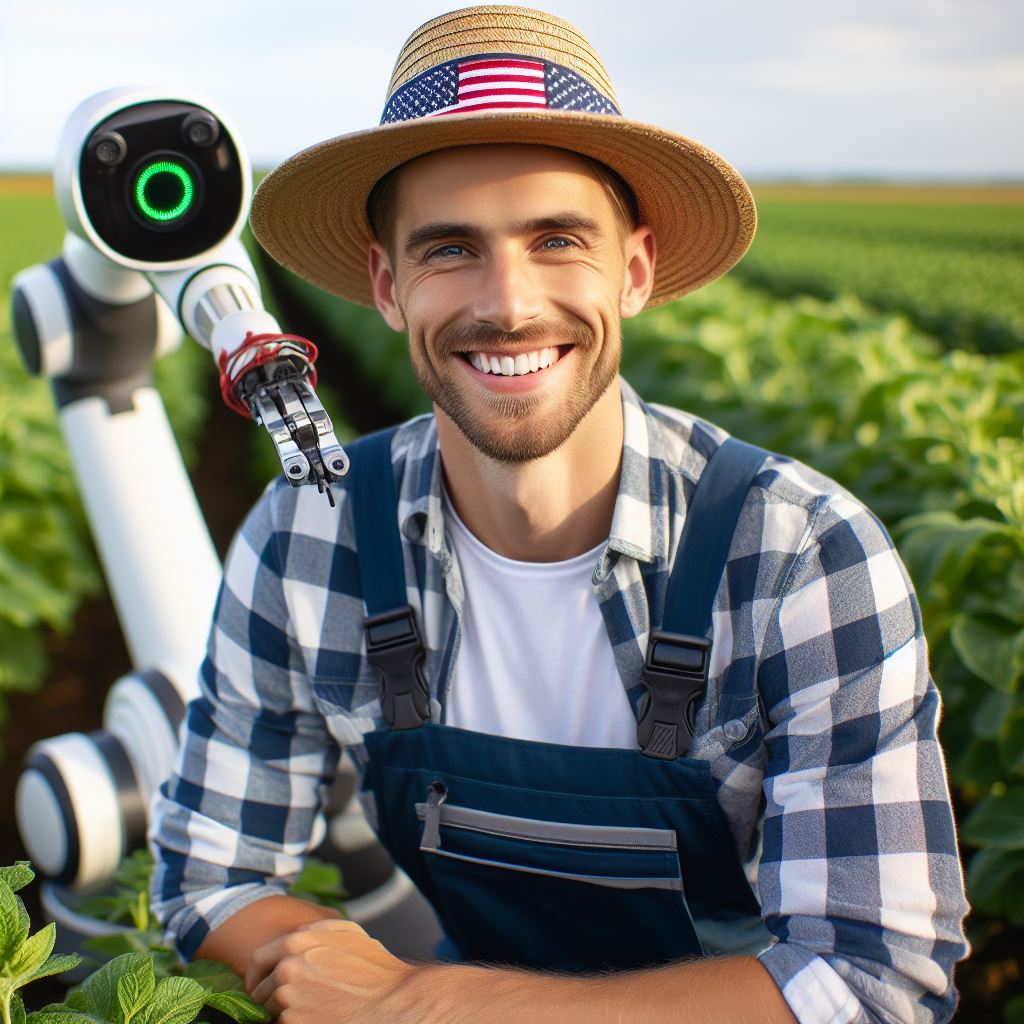Introduction
Drones have revolutionized various industries, and agriculture is no exception to this technological advancement.
In the field of pest control, drones are being increasingly used due to their efficiency and effectiveness.
Pest control is crucial in farming as it helps prevent the loss of crops caused by pests such as insects, weeds, and diseases.
Traditional methods like manual spraying can be time-consuming, labor-intensive, and may have limited coverage.
Drones, on the other hand, offer a faster, more precise, and cost-effective solution.
The study focuses on the use of drones for pest control in agriculture. It aims to examine the advantages and challenges of incorporating drone technology in this field.
Additionally, the study evaluates the impact of drone-based pest control on crop health, production, and overall yield.
By using drones for pest control, farmers can reduce chemical usage, lower the risk of exposure to harmful substances, and minimize environmental impact.
Drones equipped with high-resolution cameras and sensors can accurately identify areas infested with pests, enabling targeted treatment.
Despite its potential advantages, the study also considers challenges such as regulatory restrictions, technological limitations, and the need for skilled operators.
Overcoming these obstacles is essential to fully utilize the benefits drone technology offers in pest control.
In fact, drone technology has the potential to revolutionize pest control in farming.
This study provides an overview of its importance and aims to offer insights into the implementation and benefits of using drones for effective pest management in agriculture.
Benefits of Using Drones in Pest Control
Increased efficiency and accuracy
Drones can cover larger areas and detect pests more quickly, improving overall efficiency.
They can provide real-time data, allowing pest control professionals to make more accurate decisions.
Drones equipped with thermal cameras can identify pest infestations by detecting temperature variations.
By precisely targeting affected areas, drones enable more effective treatment and minimize damage.
Cost-effectiveness
Using drones reduces the need for manual labor and expensive equipment, resulting in cost savings.
They provide a more cost-effective solution for large-scale pest control operations.
Drones eliminate the need for frequent visits to survey sites, reducing transportation and labor costs.
With their ability to cover vast areas quickly, drones can significantly reduce time spent on pest control tasks.
Reduced exposure to harmful chemicals
Employing drones minimizes the need for direct contact with pesticides, protecting workers’ health.
Operators can effectively control pests from a safe distance using drones.
By reducing the amount of chemicals used through targeted treatment, drones limit environmental impact.
Drone technology allows for precise application of pesticides, minimizing the risk to non-target organisms.
Access to difficult-to-reach areas
Drones can navigate through complex terrain to reach remote or inaccessible locations.
They can access areas such as rooftops, trees, or narrow spaces where pests may hide.
With their agility and maneuverability, drones provide access to areas that would otherwise be challenging to reach.
Drones equipped with cameras allow for thorough inspections of inaccessible areas, ensuring comprehensive pest control.
In essence, the use of drones in pest control offers numerous benefits.
They increase efficiency and accuracy by covering large areas, providing real-time data, and targeting affected areas precisely.
Drones are cost-effective compared to traditional methods, reducing labor, equipment, and transportation costs.
They also minimize exposure to harmful chemicals, protecting the health of workers and reducing environmental impact.
Furthermore, drones enable access to difficult-to-reach areas, ensuring thorough inspections and effective pest control.
Incorporating drone technology into pest control practices can revolutionize the industry, enhancing results while promoting safety and sustainability.
Read: GPS in Farming: How It Revolutionizes Agriculture
Study Methodology
The study methodology for researching the application of drone technology in pest control involves defining research objectives, selecting suitable participants, determining data collection methods, and allocating a study duration.
Research objectives
The primary objective of this study is to evaluate the effectiveness and efficiency of using drones in pest control activities.
The researchers aim to determine whether drone technology can enhance pest control operations, reduce costs, and improve overall outcomes.
Additionally, the study seeks to identify any potential limitations or challenges associated with implementing drone technology in this field.
Sample selection
To obtain comprehensive results, a diverse sample of participants will be selected for this study.
Pest control professionals with varying levels of experience will be included to provide insights from different perspectives.
Additionally, drone operators who have successfully integrated drones into pest control activities will be selected to share their expertise.
The sample selection process will consider the geographic location and availability of participants.
Transform Your Agribusiness
Unlock your farm's potential with expert advice tailored to your needs. Get actionable steps that drive real results.
Get StartedData collection methods
To gather relevant data, a combination of survey questionnaires, interviews, and direct observations will be utilized.
Participants will be asked to complete surveys regarding their experiences and opinions on using drones in pest control.
In-depth interviews will be conducted to gain further insights into the benefits, challenges, and recommendations related to drone-assisted pest control.
Furthermore, researchers will directly observe drone operations during pest control activities to gather real-time data on effectiveness and efficiency.
Study duration
The study will be conducted over a period of six months to ensure sufficient time for comprehensive data collection and analysis.
This duration will enable researchers to observe various pest control activities across different seasons, ensuring a holistic understanding of the advantages and limitations of drone technology in pest control.
Additionally, the study duration allows for the evaluation of long-term effects and potential changes in pest control practices resulting from drone integration.
By implementing this study methodology, researchers aim to gather valuable insights that can inform the future adoption and utilization of drone technology in pest control.
The data collected will contribute to enhancing pest control practices, streamlining operations, and maximizing outcomes in a more efficient and sustainable manner.
Additionally, the study findings can guide regulatory bodies and policymakers in developing appropriate guidelines and regulations for the integration of drones into pest control activities.
Read: AI and Agri: The Future of Crop Management
Results and Findings
Effectiveness of drones in pest control
Drone technology has proven to be highly effective in pest control operations.
With their ability to reach remote and inaccessible areas, drones can easily identify pest infestations and deliver targeted treatments.
The use of drones in pest control has shown significant success rates in eliminating pests.
Drones equipped with high-resolution cameras provide real-time data, allowing operators to accurately assess the extent of infestations and apply appropriate measures.
Comparison with traditional pest control methods
Compared to traditional pest control methods, drone technology offers numerous advantages.
Firstly, drones can cover large areas quickly and efficiently, saving time and resources.
This makes them ideal for monitoring and treating vast agricultural land.
Unlike traditional methods, drones minimize human intervention, reducing the risk of pesticide exposure for workers.
Moreover, drones can navigate complex terrains and reach areas that are otherwise challenging to access using conventional techniques.
Drones also provide cost-effective solutions for pest control.
Traditional methods often require extensive manpower and equipment, resulting in higher operational costs.
Drones, on the other hand, offer a more streamlined approach, reducing overall expenses for farmers.
Reduction in crop loss
One of the key findings of this study is that the use of drones in pest control leads to a significant reduction in crop loss.
By effectively identifying and treating pest infestations, farmers can protect their crops from damage caused by pests.
With the ability to detect pests early on, drones enable farmers to implement preventive measures promptly.
This proactive approach reduces the risk of major crop losses and ensures a higher yield at harvest time.
By utilizing drones, farmers can monitor their fields regularly and address pest issues before they escalate, thus preserving their crop quality and quantity.
This ultimately leads to increased productivity and improved profitability for farmers.
Economic benefits for farmers
Another significant finding is the economic benefits that drones provide to farmers.
By utilizing drones for pest control, farmers can save on labor costs and reduce their reliance on expensive machinery and equipment.
Furthermore, drones help farmers optimize their pesticide usage. With accurate mapping and targeted application, drones minimize the need for excessive pesticide spraying.
This not only reduces costs but also minimizes environmental impact by decreasing chemical residues.
By adopting drone technology for pest control, farmers also gain a competitive edge in the market.
The use of advanced tools and techniques demonstrates their commitment to sustainable and efficient farming practices, attracting environmentally-conscious consumers and potentially increasing demand for their produce.
In general, the study reveals that drones are highly effective in pest control operations.
They outperform traditional methods in terms of efficiency, accessibility, and cost-effectiveness.
Drones significantly reduce crop losses and provide economic benefits for farmers.
Embracing drone technology in pest control is a valuable investment for the agricultural industry.
Read: Climate-Smart Farming Innovations

Case Studies
Example 1: Use of Drones in Vineyards
One real-world example of employing drone technology in pest control is its use in vineyards.
Let’s explore the challenges faced, positive outcomes, and lessons learned from this application.
1. Challenges Faced
Introducing drones into vineyards initially presented some obstacles.
First, there was a learning curve associated with operating the drones and understanding their capabilities.
Second, vineyards often have complex terrain, making navigation a challenge for the drones.
Third, drones had to be equipped with the necessary sensors and software to effectively identify pests and assess vine health.
2. Positive Outcomes
Despite the challenges, the use of drones in vineyards has yielded numerous positive outcomes.
Drones provide a cost-effective and efficient method for aerial surveys, enabling vineyard owners to monitor their crops more frequently and precisely.
They offer a bird’s-eye view, allowing for early detection of pests or diseases, thus preventing potential crop damage.
Moreover, drones facilitate the collection of accurate data for remote sensing and analysis, contributing to data-driven decision-making in vineyard management.
3. Lessons Learned
Through the implementation of drones in vineyards, valuable lessons have been learned.
One key lesson is the importance of customization. Vineyards have unique characteristics and requirements, necessitating bespoke drone solutions.
Additionally, regular maintenance and calibration of the drones are crucial to ensure accurate data collection and reliable performance.
Furthermore, training vineyard staff to operate and interpret drone-collected data is essential for maximizing the benefits of this technology.
Example 2: Implementation in Large-Scale Crop Fields
Another compelling case study involves the implementation of drone technology in large-scale crop fields.
Let’s explore the advantages of this technology, its impact on pest monitoring and detection, as well as its influence on crop yields.
1. Advantages of Drone Technology
Integrating drones into large-scale crop fields offers several advantages.
Drones can cover extensive areas quickly, providing efficient monitoring and reducing manual labor.
Additionally, drones equipped with high-resolution cameras and thermal sensors offer detailed imagery and facilitate precise identification of potential pest infestations.
Furthermore, drones can operate autonomously or under remote human control, offering flexibility and adaptability to the needs of farmers.
2. Improved Pest Monitoring and Detection
Drone technology revolutionizes the way pests are monitored and detected in large-scale crop fields.
Traditional methods often involve random sampling, leading to underestimation or delayed detection of infestations.
Drones, on the other hand, enable targeted scouting and monitoring, allowing for early identification of problem areas.
This proactive approach enables farmers to take swift corrective actions, such as targeted pesticide applications or localized pest management strategies, minimizing crop losses.
3. Impact on Crop Yields
The implementation of drone technology has a direct impact on crop yields.
By improving pest monitoring, drones help farmers maintain healthier crops and reduce yield losses caused by pests.
Early detection and timely intervention enable farmers to prevent the escalation of pest infestations, resulting in higher overall crop yields.
Additionally, drones can assist in the assessment of crop health, nutrient deficiencies, and irrigation needs, further enhancing yield optimization strategies.
In review, real-life case studies demonstrate the remarkable potential of drone technology in pest control.
Whether it is in vineyards or large-scale crop fields, drones offer numerous advantages, including efficient monitoring, early pest detection, and enhanced crop yields.
Despite initial challenges, these case studies provide valuable insights and guidance for successful implementation and customization of drones to address specific pest control needs.
Read: Precision Ag: Revolutionizing Farms
Limitations and Challenges
Weather conditions and flight restrictions
- Drones are affected by adverse weather conditions such as high winds and heavy rain.
- These conditions limit their ability to effectively navigate and carry out pest control operations.
- Flight restrictions imposed by aviation authorities also pose challenges to drone-based pest control.
Battery life and flight time limitations
- Drones have limited battery life, typically ranging from 20 to 30 minutes.
- This limits the time they can spend in the air for pest control purposes.
- Longer flight times may require additional batteries or frequent recharges, causing delays and inefficiencies.
Skill requirement and training for operators
- Operating drones for pest control requires specialized knowledge and skills.
- Operators need to understand pest behavior, pesticide application, and drone flight procedures.
- Proper training is crucial to ensure safe and effective pest control operations using drones.
Regulatory and privacy concerns
- The use of drones in pest control is subject to regulations imposed by aviation and environmental authorities.
- Compliance with these regulations can be challenging and may require additional permits and certifications.
- Privacy concerns arise due to the potential intrusion of drones in private spaces during pest control activities.
Addressing these limitations and challenges is essential to maximize the potential of drone technology in pest control.
Continued research and development can help overcome these obstacles and improve the efficiency and effectiveness of drone-based solutions.
Key Takeaways:
- Adverse weather conditions and flight restrictions limit the effectiveness of drones for pest control.
- Limited battery life and flight time pose constraints on the duration of pest control operations.
- Specialized skills and training are required for operators to safely and effectively operate drones in pest control.
- Regulatory compliance and privacy concerns must be addressed to ensure responsible and legal use of drones in pest control.
Future Implications and Adoption
Potential advancements in drone technology for pest control
- Improved autonomous capabilities will enhance efficiency and accuracy in pest detection and eradication.
- Advanced sensors and imaging systems can provide real-time data for precise targeting and analysis.
- Integration of artificial intelligence algorithms will enable drones to identify and classify pests rapidly.
- Miniaturized and lightweight drones will be developed, allowing access to confined spaces for pest control.
- Longer flight times and increased payload capacities will enhance the effectiveness of drone operations.
Integration with other agricultural processes
- Drones can be integrated with precision agriculture techniques to optimize pesticide application and reduce environmental impact.
- The data collected by drones can be utilized for crop health monitoring and yield estimation, maximizing overall agricultural productivity.
- Implementation of drone technology can streamline and automate pest control activities, saving time and labor costs.
Adoption challenges and opportunities
- Regulatory frameworks need to be developed to address safety, privacy, and legal concerns associated with drone operations.
- Proper training and certification programs should be established to ensure the competent operation of pest control drones.
- The initial investment required for acquiring drone systems may pose a financial barrier for some pest control companies.
- Partnerships between drone manufacturers and pest control businesses could create new opportunities for innovation and collaboration.
Predictions for future use of drones in pest control
- Drones will become standard tools in the pest control industry, revolutionizing traditional pest management approaches.
- The use of drones will lead to more environmentally friendly pest control practices, minimizing the use of harmful chemicals.
- Real-time data analysis and predictive algorithms will allow proactive pest control measures, preventing and mitigating infestations.
- Drones will be increasingly employed in urban areas to combat pests such as mosquitoes, rodents, and termites.
- Collaboration between drone manufacturers, software developers, and pest control experts will drive innovation and further advancements.
In a nutshell, the future of drone technology in pest control looks promising.
Advancements in autonomous capabilities, sensors, and integration with agricultural processes will revolutionize pest management practices.
However, adoption challenges and regulatory considerations must be addressed for widespread implementation.
With the potential to improve efficiency, minimize environmental impact, and enhance pest control outcomes, drones are set to play a pivotal role in the future of pest management.
Conclusion
Recap of benefits and findings
In this study, we explored the use of drone technology in pest control and uncovered several benefits.
Showcase Your Farming Business
Publish your professional farming services profile on our blog for a one-time fee of $200 and reach a dedicated audience of farmers and agribusiness owners.
Publish Your ProfileDrones provide a cost-effective and efficient solution to monitor and eliminate pests in large areas.
They can navigate difficult terrains and reach inaccessible areas, ensuring comprehensive pest control.
Furthermore, drones equipped with thermal cameras can detect pest hotspots and target them with precision.
Our research also found that the use of drones reduced the need for harmful pesticides, promoting environmental sustainability.
Encouragement for further research and adoption
The promising results of this study encourage further research on drone technology in pest control.
There is a need to explore different drone models and payloads for optimal performance in pest eradication.
Additionally, more studies should focus on the economic benefits of using drones compared to traditional pest control methods.
This research can aid in the adoption of drone technology by pest control companies and regulators.
Final thoughts on the potential impact of drone technology in pest control
Overall, drone technology has the potential to revolutionize the field of pest control.
Its ability to cover large areas efficiently, identify pest hotspots, and reduce the use of harmful chemicals is commendable.
Implementing drones in pest control operations can not only improve efficacy but also contribute to a greener and sustainable future.
It is crucial for stakeholders to recognize and embrace this technology for a more effective and environmentally friendly pest control industry.




